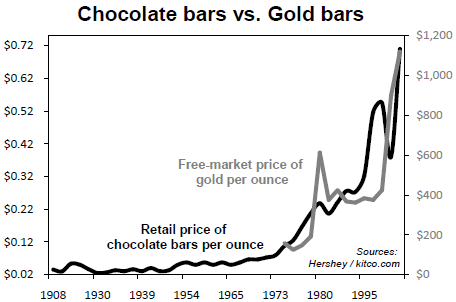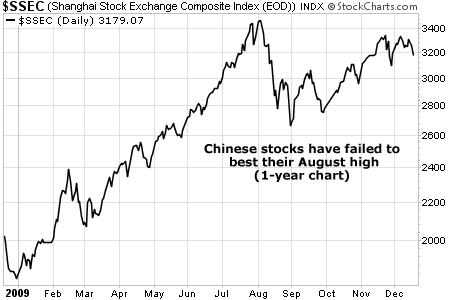| Home | About Us | Resources | Archive | Free Reports | Market Window |
The Inflation Hedge That Returned 7,000%By
Saturday, December 19, 2009
Which asset do you think is a better hedge against inflation – gold or chocolate bars?
Since I'm asking, you can probably guess it must be chocolate bars. But how sure are you? Would you be willing to bet $1,000 on your answer? I would. I did the math. Franklin Delano Roosevelt signed Executive Order 6102 into law on April 5, 1933. The order forbade the private ownership of gold (which was labeled "hoarding") by all U.S. citizens. Americans had until midnight on May 1, 1933 (the Communist's "May Day"), to turn in their gold bullion to the Federal Reserve. They were paid $20.67 per ounce for their gold. Ignoring the order was punishable by a fine of up to $10,000 and 10 years in prison. Interestingly, the president derived his authority for the order from the 1917 Trading with the Enemy Act, which Congress passed to give the government the power to sanction citizens who were supporting Germany in World War I. (Keep that in mind the next time you consider supporting any effort to expand the government's authority during a war. You never know what it will do with the power when the war is over... but you know it won't give it up.) The Gold Reserve Act of 1934 amended Executive Order 6102 to make gold clauses in contracts unenforceable and fix the value of gold to $35 per ounce. What the government had seized the year before – offering only $20.67 in compensation – was now worth $35. Law-abiding citizens turned in a little more than 500 metric tonnes of gold (16,075,373.18 troy ounces). These people were robbed of at least $14.33 per ounce of gold, a theft of more than $230 million. Congress repealed the limitation on private gold ownership in 1974, and Gerald Ford signed the bill into law on December 31. Beginning in January 1975, Americans could buy and own gold bullion again. This history is important to know because the market for gold was so tightly regulated during these 42 years that the market prices of gold aren't reliable. If you're studying the free-market price action of gold, you have to wait until 1975 for a true free market in gold bullion to return to the United States. In January 1975, gold traded for $175 per ounce. The price of a one-ounce chocolate bar was $0.15. Today, the price of gold is roughly $1,100 per ounce, an increase of 603%. A one-ounce chocolate bar goes for about $1.15, an increase of 633%. Either asset would have protected you against the Federal Reserve. However, chocolate bars – at least their retail price – have slightly outperformed gold for the period.  Now consider this... The world's top chocolate-bar maker has vastly outperformed gold – and nearly every other possible investment. Buying shares of Hershey would have earned you more than 7,000% on your money from 1980 until today – better than 15% per year, assuming you reinvested the dividends. Hershey is the sort of company I think every investor should own over the coming years. If you've read any of my commentary over the past year, you know I expect the huge expansion in the Federal Reserve's balance sheet to cause inflation soon. This inflation will wipe out the unprepared. To get prepared, I recommend you buy gold and silver. These two will soar as the dollar crumbles under the U.S. government's crushing debt load. I also recommend you own companies that make for quintessential Warren Buffett investments, like Hershey, Coke, Kraft, and Nestle. These companies possess what Buffett calls "economic goodwill." It's one of the great secrets of rich investors... one that will protect you from inflation (read Buffett's 1983 letter to shareholders for a full expiation). Businesses with lots of economic goodwill have strong consumer franchises. They use their brand loyalty to continually raise prices as input costs rise (folks think of "Coke" when they hear soda, they think "Hershey" when they hear chocolate). This brand loyalty allows them to generate high returns on capital with little additional ongoing investment. They can raise prices as needed. Higher prices translate into more money returned to shareholders... for years and years. In a recent New York Times op-ed, Buffett warned about inflation. He, like me, noted the government is going to have to finance its debts with printed money. He's preparing for this inflation with stocks like Hershey. You should, too. Good investing, Porter Stansberry P.S. I devoted the latest issue of my investment advisory to the secret of preparing for inflation with this idea. I believe there's an incredible upcoming opportunity to buy Hershey for less than it's selling for today. It will be an investment likely to make you more than 20 times your money over the coming years. You can get all of the details with a subscription, which you can learn about here.
Further Reading:
The Gift of Capital Efficiency Market NotesCHINA'S UPTREND IS IN DANGER
|
In The Daily Crux
Recent Articles
|


